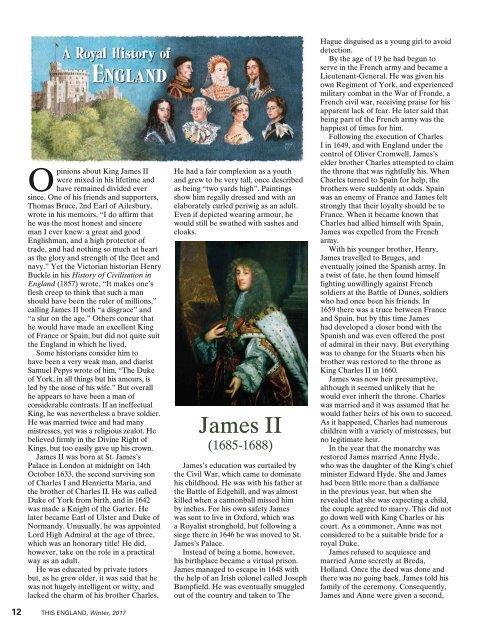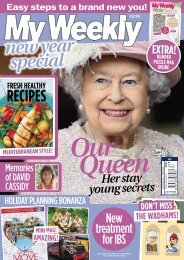This England
This England is the quarterly magazine for all who love our green and pleasant land and are unashamedly proud of their English roots. Published since 1968 the magazine has now become one of England’s best loved magazines and has a readership of over 115,000 people from around the world. As well as being popular in England it outsells all other British heritage magazines in Canada, Australia, New Zealand, South Africa and is sent to readers in every country of the world. Published in Cheltenham, in the heart of picturesque Gloucestershire, the magazine is edited, printed and despatched direct from England. Subscribe today and celebrate all that is best about England and the English way of life.
This England is the quarterly magazine for all who love our green and pleasant land and are unashamedly proud of their English roots. Published since 1968 the magazine has now become one of England’s best loved magazines and has a readership of over 115,000 people from around the world. As well as being popular in England it outsells all other British heritage magazines in Canada, Australia, New Zealand, South Africa and is sent to readers in every country of the world.
Published in Cheltenham, in the heart of picturesque Gloucestershire, the magazine is edited, printed and despatched direct from England. Subscribe today and celebrate all that is best about England and the English way of life.
Create successful ePaper yourself
Turn your PDF publications into a flip-book with our unique Google optimized e-Paper software.
Opinions about King James II<br />
were mixed in his lifetime and<br />
have remained divided ever<br />
since. One of his friends and supporters,<br />
Thomas Bruce, 2nd Earl of Ailesbury,<br />
wrote in his memoirs, “I do affirm that<br />
he was the most honest and sincere<br />
man I ever knew: a great and good<br />
Englishman, and a high protector of<br />
trade, and had nothing so much at heart<br />
as the glory and strength of the fleet and<br />
navy.” Yet the Victorian historian Henry<br />
Buckle in his History of Civilisation in<br />
<strong>England</strong> (1857) wrote, “It makes one’s<br />
flesh creep to think that such a man<br />
should have been the ruler of millions,”<br />
calling James II both “a disgrace” and<br />
“a slur on the age.” Others concur that<br />
he would have made an excellent King<br />
of France or Spain, but did not quite suit<br />
the <strong>England</strong> in which he lived.<br />
Some historians consider him to<br />
have been a very weak man, and diarist<br />
Samuel Pepys wrote of him, “The Duke<br />
of York, in all things but his amours, is<br />
led by the nose of his wife.” But overall<br />
he appears to have been a man of<br />
considerable contrasts. If an ineffectual<br />
King, he was nevertheless a brave soldier.<br />
He was married twice and had many<br />
mistresses, yet was a religious zealot. He<br />
believed firmly in the Divine Right of<br />
Kings, but too easily gave up his crown.<br />
James II was born at St. James’s<br />
Palace in London at midnight on 14th<br />
October 1633, the second surviving son<br />
of Charles I and Henrietta Maria, and<br />
the brother of Charles II. He was called<br />
Duke of York from birth, and in 1642<br />
was made a Knight of the Garter. He<br />
later became Earl of Ulster and Duke of<br />
Normandy. Unusually, he was appointed<br />
Lord High Admiral at the age of three,<br />
which was an honorary title! He did,<br />
however, take on the role in a practical<br />
way as an adult.<br />
He was educated by private tutors<br />
but, as he grew older, it was said that he<br />
was not hugely intelligent or witty, and<br />
lacked the charm of his brother Charles.<br />
He had a fair complexion as a youth<br />
and grew to be very tall, once described<br />
as being “two yards high”. Paintings<br />
show him regally dressed and with an<br />
elaborately curled periwig as an adult.<br />
Even if depicted wearing armour, he<br />
would still be swathed with sashes and<br />
cloaks.<br />
James II<br />
(1685-1688)<br />
James’s education was curtailed by<br />
the Civil War, which came to dominate<br />
his childhood. He was with his father at<br />
the Battle of Edgehill, and was almost<br />
killed when a cannonball missed him<br />
by inches. For his own safety James<br />
was sent to live in Oxford, which was<br />
a Royalist stronghold, but following a<br />
siege there in 1646 he was moved to St.<br />
James’s Palace.<br />
Instead of being a home, however,<br />
his birthplace became a virtual prison.<br />
James managed to escape in 1648 with<br />
the help of an Irish colonel called Joseph<br />
Bampfield. He was eventually smuggled<br />
out of the country and taken to The<br />
Hague disguised as a young girl to avoid<br />
detection.<br />
By the age of 19 he had begun to<br />
serve in the French army and became a<br />
Lieutenant-General. He was given his<br />
own Regiment of York, and experienced<br />
military combat in the War of Fronde, a<br />
French civil war, receiving praise for his<br />
apparent lack of fear. He later said that<br />
being part of the French army was the<br />
happiest of times for him.<br />
Following the execution of Charles<br />
I in 1649, and with <strong>England</strong> under the<br />
control of Oliver Cromwell, James’s<br />
elder brother Charles attempted to claim<br />
the throne that was rightfully his. When<br />
Charles turned to Spain for help, the<br />
brothers were suddenly at odds. Spain<br />
was an enemy of France and James felt<br />
strongly that their loyalty should be to<br />
France. When it became known that<br />
Charles had allied himself with Spain,<br />
James was expelled from the French<br />
army.<br />
With his younger brother, Henry,<br />
James travelled to Bruges, and<br />
eventually joined the Spanish army. In<br />
a twist of fate, he then found himself<br />
fighting unwillingly against French<br />
soldiers at the Battle of Dunes, soldiers<br />
who had once been his friends. In<br />
1659 there was a truce between France<br />
and Spain, but by this time James<br />
had developed a closer bond with the<br />
Spanish and was even offered the post<br />
of admiral in their navy. But everything<br />
was to change for the Stuarts when his<br />
brother was restored to the throne as<br />
King Charles II in 1660.<br />
James was now heir presumptive,<br />
although it seemed unlikely that he<br />
would ever inherit the throne. Charles<br />
was married and it was assumed that he<br />
would father heirs of his own to succeed.<br />
As it happened, Charles had numerous<br />
children with a variety of mistresses, but<br />
no legitimate heir.<br />
In the year that the monarchy was<br />
restored James married Anne Hyde,<br />
who was the daughter of the King’s chief<br />
minister Edward Hyde. She and James<br />
had been little more than a dalliance<br />
in the previous year, but when she<br />
revealed that she was expecting a child,<br />
the couple agreed to marry. <strong>This</strong> did not<br />
go down well with King Charles or his<br />
court. As a commoner, Anne was not<br />
considered to be a suitable bride for a<br />
royal Duke.<br />
James refused to acquiesce and<br />
married Anne secretly at Breda,<br />
Holland. Once the deed was done and<br />
there was no going back, James told his<br />
family of the ceremony. Consequently,<br />
James and Anne were given a second,<br />
12 THIS ENGLAND, Winter, 2017
















